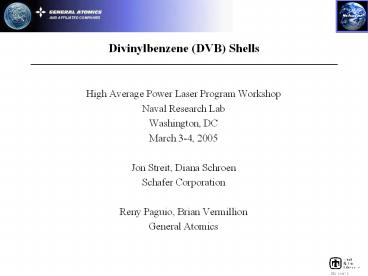Divinylbenzene (DVB) Shells - PowerPoint PPT Presentation
1 / 13
Title:
Divinylbenzene (DVB) Shells
Description:
... have continued to study density matching and gelation time, but suspect that ... Attempts were made to make the MF coating thicker, but the thickness appears to ... – PowerPoint PPT presentation
Number of Views:30
Avg rating:3.0/5.0
Title: Divinylbenzene (DVB) Shells
1
Divinylbenzene (DVB) Shells
- High Average Power Laser Program Workshop
- Naval Research Lab
- Washington, DC
- March 3-4, 2005
- Jon Streit, Diana Schroen
- Schafer Corporation
- Reny Paguio, Brian Vermillion
- General Atomics
2
Review
Parameter Value
Diameter 4 mm
Wall Thickness 300 µm
Density 100 mg/cc
Out Of Round lt1 of radius
Overcoat Thickness 1 5 µm
Non-concentricity lt1
Surface Finish 20 nm RMS
- Status at last review
- Lowest average batch NC was 3 , some shells lt
2. - PVP coating alternatives proposed.
- Different agitation methods proposed.
3
Shell Production Status
Nonconcentricity Out of 40 batches attempted
since the last meeting, our best average batch
NCs continue to be around 3 with some individual
shells lt 2. We have continued to study density
matching and gelation time, but suspect that
agitation may have the greatest effect on NC as
changing this variable has led to the greatest
improvement in NC. We experimented with applying
ultrasonic waves to improve NC, and we will
propose some new agitation methods to lower
NC. Overcoat The PVP overcoat continues to shrink
upon drying. We are screening a variety of
interfacial chemistries to try to find an
alternative that will not shrink and provide the
required surface smoothness. We have also tried
a melamine formaldehyde coating followed by an
interfacial coating.
4
Ultrasonics to Improve NC
- To reduce NC we applied ultrasonic waves to the
shell bath during gelation. - The force of ultrasonics tended to emulsify the
shells, so the sonics had to be applied in
pulses. - This method was attempted using a variety of
conditions, pulse lengths and intervals.
5
Results of Ultrasonic Disruption
Batch Density Offset (g/mL) Temperature (ºC) Pulse (s) NC
3JS10A 0.02 70 0.1 s / 59.9 s 3.6
3JS10B 0.02 70 0.1 s / 59.9 s 4.0
3JS14A 0.00 80 0.1 s / 9.9 s 4.0
3JS15B 0.00 80 0.1 s / 0.9 s 4.1
3JS16A -0.03 35 0.1 s / 59.9 s 4.8
6
Mechanical Vibration to Reduce NC
- Since ultrasonics were too disruptive to be
applied except in very short pulses, we are
attempting to develop a centering force through
mechanical vibrations. - We have attached a vibration device to the
rotavap that we use to gel the shells in which
physically vibrates the flask as the shells gel. - We will obtain results soon.
7
Paddle Agitation to Reduce NC
- We are also planning experiments to provide
additional agitation to the shells by using
paddles in the flask during the gelation period.
8
OC Chemistries Attempted
Aqueous Reactants Oil Reactant
PVP Isophthaloyl Dichloride or Terephthaloyl Dichloride
PVP/Tris(2-aminoethyl) amine Isophthaloyl Dichloride or Terephthaloyl Dichloride
Tris(2-aminoethyl)amine Isophthaloyl Dichloride or Terephthaloyl Dichloride
Ethylene Diamine Isophthaloyl Dichloride or Terephthaloyl Dichloride
Diethylene Triamine Isophthaloyl Dichloride or Terephthaloyl Dichloride
Resorcinol Isophthaloyl Dichloride or Terephthaloyl Dichloride
Piperazine Isophthaloyl Dichloride or Terephthaloyl Dichloride
2,2-Biphenol Isophthaloyl Dichloride or Terephthaloyl Dichloride
4,4-Biphenol Isophthaloyl Dichloride or Terephthaloyl Dichloride
Melamine-Formaldehyde None
- We have screened several different interfacial
coating chemistries. - Polymer has formed in all cases, but we are still
trying to determine the chemistry or combination
that will meet specifications. - We have attempted MF followed by interfacial.
9
Melamine Formaldehyde (MF) Overcoat
- Previously we coated shells in a one step process
with MF. - This process produced a relatively smooth
coating, but the coating was thin and tended to
have very small cracks when dried. - Attempts were made to make the MF coating
thicker, but the thickness appears to be reaction
limited. - Since MF adheres well to the shell, we attempted
to use it as a base for interfacial overcoats as
it might help the second overcoat adhere to the
shell as well and could possibly help increase
smoothness by slowing the interfacial reaction
down.
10
Diethylene Triamine (DET) Overcoat
DET SEM 5000x
DET Interferometer Image 107 nm RMS
- DET by itself does not tend to shrink but can
have problems adhering to the shell and is
rougher than PVP.
11
DET over MF
DET over MF SEM 5000x
DET over MF Interferometer Image 38 nm RMS
- MF followed by an interfacial DET overcoat
resulted in a coating that did not shrink , was
smoother, but had some cracking effects.
12
We have produced heater assemblies with an RF
foam coating for experiments at LANL
50 micron wire
- RF foam was chosen as it would be the most gentle
to the epoxy covering the wires, but clearly did
attack the copper.
13
Future Work
- Continue studying the effects of agitation to
reduce nonconcentricity. In addition to the new
agitation methods proposed, other methods are
being considered in response to the recent paper
concerning agitation from GA. - We have attempted gelling in a coiled tube with
periodic flow reversal. - We are also considering using our current
standard flask set up, but cycling the direction
of rotation of the flask. - Continue to investigate interfacial overcoating
chemistries that will adhere to the shell and
meet smoothness specifications. - Continue to investigate MF followed by
interfacial overcoats.

